
Northrop Grumman is partnering with NVIDIA to boost and accelerate mission performance in some of the most complex and demanding environments in the world, according to Travis Garriss, vice president and chief information and digital officer for Northrop Grumman.
“We at Northrop are using AI and partnerships with NVIDIA and other partners to really accelerate from end to end all the way across the value chain, how we deliver for our customers,” Garriss said, adding, “It starts with key partnerships like what we have with NVIDIA.”
Garriss spoke on Oct. 28 at the NVIDIA GTC conference in Washington, D.C. At its core, Northrop Grumman is an engineering company – designing and building complex systems that operate “from the harshest environments in space to the bottom of the ocean,” Garriss emphasized. These systems rely on a range of AI-enabled tools that enhance everything from software development to design simulation and testing.
In a recent collaboration, NVIDIA offered Northrop an opportunity to test an unreleased chip. “From that phone call to initial operating capability inside of our environment – three months. Full operating capacity – four months,” Garriss said. “We don’t do that without the right partnership with NVIDIA.”
Beyond engineering, Graviss said AI is transforming how Northrop Grumman manufactures mission-critical components.
He pointed to the company’s $13.5 billion investment to produce 30 million square feet, or about 500 American football fields, in manufacturing capacity, as well as an additional $200 million investment in chip fabrication.
Garriss highlighted the company’s “Quick Chip” microprocessor, which is roughly “1/100 the size of a grain of rice” and “about 1,000 times faster than the microchips inside your phone.” Northrop produces about a million microprocessors of varying speeds each year “to meet mission,” he said.
“Again, it all starts with AI and driving those capabilities and tools to the environments that need them,” Garriss noted.
He detailed how Northrop Grumman is using NVIDIA’s Isaac platform to help develop agentic systems that can “receive [data], analyze it, act on it, and execute at pace.”
“Imagine a spacecraft, the James Webb Telescope. This thing looks 13.5 billion light-years away … you don’t exactly pull up to that and type in changes when there’s an issue,” Graviss explained. “There are no hands on keyboard.”
“So, for us, it’s critical to have the right technology on board so that unmanned spacecraft can be successful in their mission. Agentic is the perfect use case for this,” he said.
The company is also using NVIDIA’s Omniverse development platform to power digital twins. “[Omniverse] gives us visibility on the ground about how things are performing in the sky,” Graviss said.
“We’re learning to use AI capabilities to drive performance at scale in pursuit of capabilities that actually produce on the ground or in the sky. … Whether we’re talking about spacecraft, airplanes, microchips, things under the ocean – our customers demand it, our partners help us facilitate it, our integrators help us achieve it, our engineers design it, and our manufacturers produce it,” he said. “[I’m] really excited to be a part of Northrop Grumman partnering with NVIDIA and executing on our AI mission together.”
